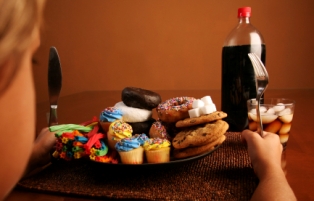The Fullness Factor
Why Certain Fatty Foods Fall Flat in Satisfying Our Appetite
Ever notice how foods loaded with fat never leave you satisfied, while low fat foods leave you feeling fuller longer?
Fat has more calories than carbohydrates and proteins (nine calories per gram as opposed to four calories per gram), so it’s natural to assume that high fat foods will leave us feeling more satiated than foods that are lower in fat. Typically this is true, but not for the potato chip snacker or for the Pillsbury plunderer. Dollars to doughnuts, these snack attackers will tell you it’s not true, as one doughnut, one chip, is never enough (a single Krispy Kreme doughnut has 12 grams of fat).
Several factors play into this dietary conundrum, one of which is whether or not what you’re consuming has any fiber in it. Fiber plays a huge role in what I like to call “the fullness factor,” as high fiber foods are digested slower, and high fiber foods take up more room in the stomach.
But there’s another factor to consider that researchers have only recently keyed into, and its name is palmitic acid.
Palmitic acid is a saturated fatty acid found primarily in dairy foods like milk, cheese, butter, and milk. Many of these ingredients are used in the production of bakery items like doughnuts, so it’s no wonder doughnuts never leave us feeing satisfied.
To study palmitic acid’s effects on appetite and brain chemistry, researchers fed a group of rats various kinds of fat. Some of them were fed palmitic acid, while others were fed oleic acid, which is an unsaturated fatty acid found primarily in vegetable oils like olive oil. They were fed these oils intravenously.
After three weeks, the researchers found that the rats fed the palmitic acid consistently ate more than the rats fed the oleic acid.
The researchers chalk up this fat find to palmitic acid’s ability to chemically alter the brain. When palmitic acid is consumed in high enough quantities, it triggers the release of a certain protein that effectively renders leptin and insulin useless. Leptin and insulin are hormones that help regulate appetite. Among other functions, they tell the brain when the body feels “full.”
The study was published in the Journal of Clinical Investigation and conducted by scientists from the University of Texas Southwestern Medical Center.
As a natural health advocate— and you, a natural health follower— scarfing on doughnuts and snicker doodles to test the scientists’ findings is not the best of idea. However, I mention this study because each and every one of us “cheats” now and then, so it’s helpful to understand why certain “cheat” foods leave us feeling full, while others leave us feeling flat or unsatisfied.
Besides the kinds of food we’re eating, we also need to take into consideration how fast we’re eating. As I wrote in a past Mangano Minute, there’s about a 20 minute delay between our brain and stomach in recognizing whether or not we feel full. That’s why people who are trying to lose weight are advised to eat slower. Eating slower not only enables the brain to recognize that fullness factor, but it also helps us enjoy our foods a bit more. And enjoyment is the second most important thing in our daily dinings, the most important one being nutrition, of course.
Sources:
foodnavigator.com
krispykreme.com
Related Posts
- Low HDL Cholesterol Levels: A Risk Factor for Dementia, Study Shows
- Personality Traits Are A Contributing Factor In Alzheimer’s Risk, Study Shows
 
|
Enjoy this article? We guarantee your privacy. Your email address will NEVER be rented, traded or sold. |
Visit my new site: Self Help On The Web
 |
 |
Posted: September 27th, 2009 under Appetite, Brain Chemistry.
Tags: feeling full, fullness factor, insulin, leptin, oleic acid, overindulgence, palmitic acid







